



“Innovation Systems and Development Strategies for the Third Millennium” Innovation and sustainability in economic development Rainer Walz Fraunhofer ISI Karlsruhe, Germany
Overview • Interpretations of sustainability • economic development and sustainability in the North • innovation strategies for sustainability • role of innovations for sustainability in the South • conclusions and outlook
Political and economic interpretation of sustainability Ecological Essential problems as (critical) bottleneck resources Sustainable Critical su- development stainability in politics in economics Economic Opportunity development costs of and social conservation dimension
Environmental Kuznets Curve Environmental pressure phase 1 phase 2 phase 3 GDP/capita
Environmental Kuznets Curve • Mixed empirical results • different factors influencing EKC – behaviour and institutions – technological progress – structural change => systems of innovation • conclusions – EKC less valid for sustainability problems – no „natural“ effect, policies necessary to foster sustainability innovations
Innovation strategies for sustainability Increasing complexity Environmentally Closing Integration of acceptable material product policy technologies cycles and product use End- Inte- of- grated pipe
Implications of sustainability strategies • Address fundamental strategic decisions of companies => risks and chances • High importance of lead markets and learning processes • Changing patterns of institutions and behaviour => co-evolution of subsystems
Time scale and geographic scale for societal responses
Three scenarios for the South ? • Tunneling through the Environmental Kuznets Curve? • lead markets for sustainability innovations? • advantages in overcoming path dependency?
Tunnelling through the Environmental Kuznets Curve ? Environmental pressure safe limit ������������������� ������������������� tunnel phase 1 phase 2 phase 3 GDP/capita
Tunnelling through the Environmental Kuznets Curve ? • Application of late comer advantage concept • Problems – ECK might not exist in the North – Reallocation of „dirty‘‘ industries – Absorptive capacity, learning important • Perpetuation of existing dependencies
Lead markets for sustainability in the South? • Deficiencies with regard to typical lead market demand conditions • Very high problem driven pressure • Natural requirements for technical functioning ? • Favourable policies and regulations? • Understanding of system of sustainability innovations necessary
Path dependencies • Technological lock-in, e.g. in energy and water industry • political lock-in: power of losers prevail • social lock-in: no co-evolution of social system
Conclusions • Technological progress and structural change are key for reconciling economic development and sustainability => systems of innovation important • different innovation strategies for sustainability with increasing importance of learning effects and co-evolution of subsystem • innovation system which first masters these complex tasks gains competitive advantages • policies necessary which lead to integration of environmental and innovation policies • no clear picture for the South: possible scenarios range from perpetuating dependencies to gaining advantages
Research agenda • Functioning of a system of sustainability innovations • existing bottlenecks and potential policies for sustainability lead markets in the south • analysis of lock-in situations and comparison between countries/regions/continents • performance and importance of a system of sustainability innovation in comparison to other factors
interpretations of sustainability • Politics – tension between short term economic development and long term needs – ecological sustainability as bottleneck for long term needs – specification of targets in conventions, declarations • critical sustainability concept in economics – preserve essential resources – not all environmental problems are sustainability problems – consider opportunity costs of conserving essential resources • relationship between economic development and ecological sustainability
Strategies for closing material loops large Use Product Component R euse Production Further use Maintenance R emanufacturing Upgrading New R ecycled materials materials Materials recycling Disposal Ecological/economic quality E nergy recovery R aw materials R e-Mining Natural L and fill resources R ecycling strategies small
Winners and losers of sustainability innovations 100 change in 1.000 ��������� ������ services ��������� ���������� ������ 50 ���������� ��������� ������ investment goods ���������� �������� ��������� ���������� ������ ��������� ���������� �������� ��������� ���������� ���������� �������� 0 ��������� �������� ���������� ���������� �������� ���������� �������� ��������� ���������� �������� ���������� ���������� �������� ���������� �������� ������ basic goods �������� ���������� ���������� �������� �������� ������ ���������� ���������� ���������� ���������� plastic sust. paper life span Car-Sharing ������ total -50 ���������� ���������� ������ recycling extension -100
Recommend
More recommend